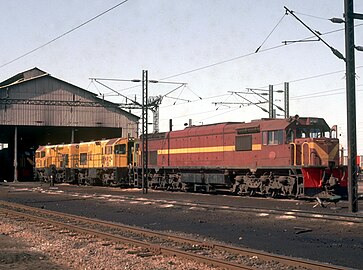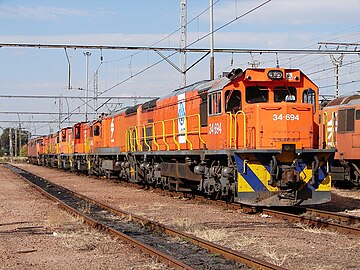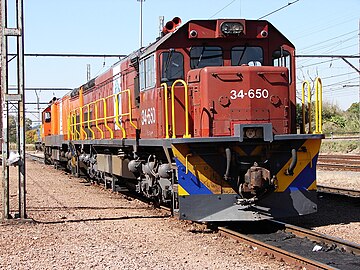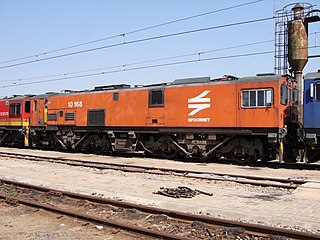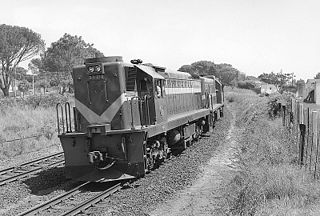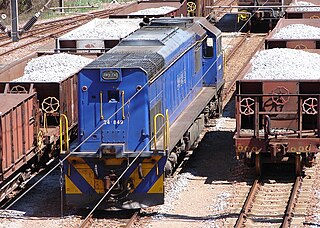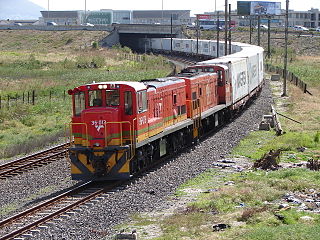Rebuilding and modification
Class 39-000
The Class 39-000 type GT26CU-3 diesel-electric locomotives were to be rebuilt from Class 34-600, 34-800 and 37-000 locomotives. The project commenced in 2005, using suitable frames from wrecked locomotives. Rebuilding was done at the Transwerk shops in Bloemfontein between 2006 and 2008. [2] [6]
It was intended to produce one hundred Class 39-000 locomotives but in spite of the technical success of the project, rebuilding was halted after completing the first five locomotives due to higher than anticipated cost. It was decided, instead of rebuilding old locomotives, to continue the program by building fifty new Class 39-200 locomotives from imported and locally produced components. Three Class 34-600 locomotives, numbers 34-620, 34-635 and 34-674, were rebuilt to Class 39-000 before the rebuilding project was halted. [7]
Traction motor upgrade
In 2010, an upgrading project commenced at the Koedoespoort Transnet Rail Engineering shops to upgrade Class 34-600 locomotives by, amongst other modifications, replacing the GM-EMD D29B with GM-EMD D31 traction motors, thereby improving their performance to the standard of the Class 37-000. [6]
Locomotives that are known to have undergone this upgrade are annotated "D31 TM" in the "Leased, rebuilt or sold to" column in the table.
Service
South African Railways
In SAR, Spoornet and Transnet Freight Rail (TFR) service, the Class 34-600s worked on most mainlines and some unelectrified branch lines in the central, eastern, northern and northeastern parts of South Africa. [3]
National Railways of Zimbabwe
From at least 1988 until at least 1992, the National Railways of Zimbabwe (NRZ) hired type GT26MC Class 34-600 locomotives from the SAR and later Spoornet. Locomotives which were observed to be working on the NRZ between April 1988 and September 1992 are annotated "NRZ" in the "Leased, rebuilt or sold to" column in the. [8]
NLPI Ltd.
NLPI Limited, abbreviated from New Limpopo Projects Investments, a Mauritius-registered company, specialises in private sector investments by using the build-operate-transfer (BOT) concept. It had three connected railway operations in Zimbabwe and Zambia which formed a rail link between South Africa and the Democratic Republic of Congo. [2]
In Zambia, the RSZ locomotive fleet included former ZR locomotives, but the rest of the locomotive fleet of all three operations consisted of South African GM-EMD Classes 34-200, 34-600 and 34-800 and GE Classes 35-000 and 35-400 locomotives from Spoornet and later TFR. These locomotives were sometimes marked or branded as either BBR or LOG or both, but their status, whether leased or loaned, was unclear since they were still on the TFR roster and still often worked in South Africa as well. [2]
Class 34-600 locomotives which served with NLPI include the locomotives annotated "NLPI" in the "Leased, rebuilt or sold to" column in the table.
Zambia Railways, the state-owned holding company, resumed control of the Zambian national rail network on 11 September 2012. This followed the Zambian government's decision to revoke the operating concession awarded to RSZ after Finance Minister Alexander Chikwanda claimed that RSZ had "blatantly disregarded the provisions of the agreement" and had been "acting in a manner prejudicial to the interests of Zambians". [9]
Sheltam
One of the Class 34-600 locomotives, no. 34-640, was sold to Sheltam, a locomotive hire and repair company based at the Douglas Colliery near Witbank in Mpumalanga which undertakes complete operating contracts and maintenance contracts. By the turn of the millennium, Sheltam locomotives were operating at Randfontein Estates Gold Mine in Gauteng, in Mpumalanga at Douglas and Vandyksdrift Collieries and at SAPPI, Ngodwana. They also operated on Spoornet's Newcastle-Utrecht branch in KwaZulu-Natal and on Kei Rail in the Eastern Cape. Outside South Africa, they operated on the BBR, NLL and RSZ lines through Zimbabwe and Zambia and in the Democratic Republic of the Congo. [2] [10]
Chemin de Fer Congo-Ocean
Six Class 34-600 locomotives were leased to the Congolese railway, the Chemin de Fer Congo-Ocean (CFCO), where they were renumbered in the range from CC801 to CC806. [2]
Camrail
Six more locomotives which were at one time erroneously believed to have also gone to CFCO in the Congo, are now believed to have gone to Camrail in the Republic of Cameroon in about 2002, where they were renumbered in the range from CC2601 to CC2606. The order of their renumbering is not known. [8]
Ferrovia Centro Atlântico
Five Class 34-600 locomotives went to Ferrovia Centro Atlântico (FCA) at Divinipolis in Brazil, where they run on 1,000 mm (3 ft 3+3⁄8 in) metre gauge. While they were initially part of Spoornet Traction's leasing scheme, they were later renumbered onto the FCA roster in the number range from 8226 to 8230. [2]
Ferrovia Sul Atlântico
Ten Class 34-600 locomotives went to Ferrovia Sul Atlântico (FSA) at Curitiba in Brazil, where they also run on Metre gauge. While they were also initially part of Spoornet Traction's leasing scheme, they were later renumbered onto the FSA roster in the number range from 8231 to 8240. [2]
This page is based on this
Wikipedia article Text is available under the
CC BY-SA 4.0 license; additional terms may apply.
Images, videos and audio are available under their respective licenses.


